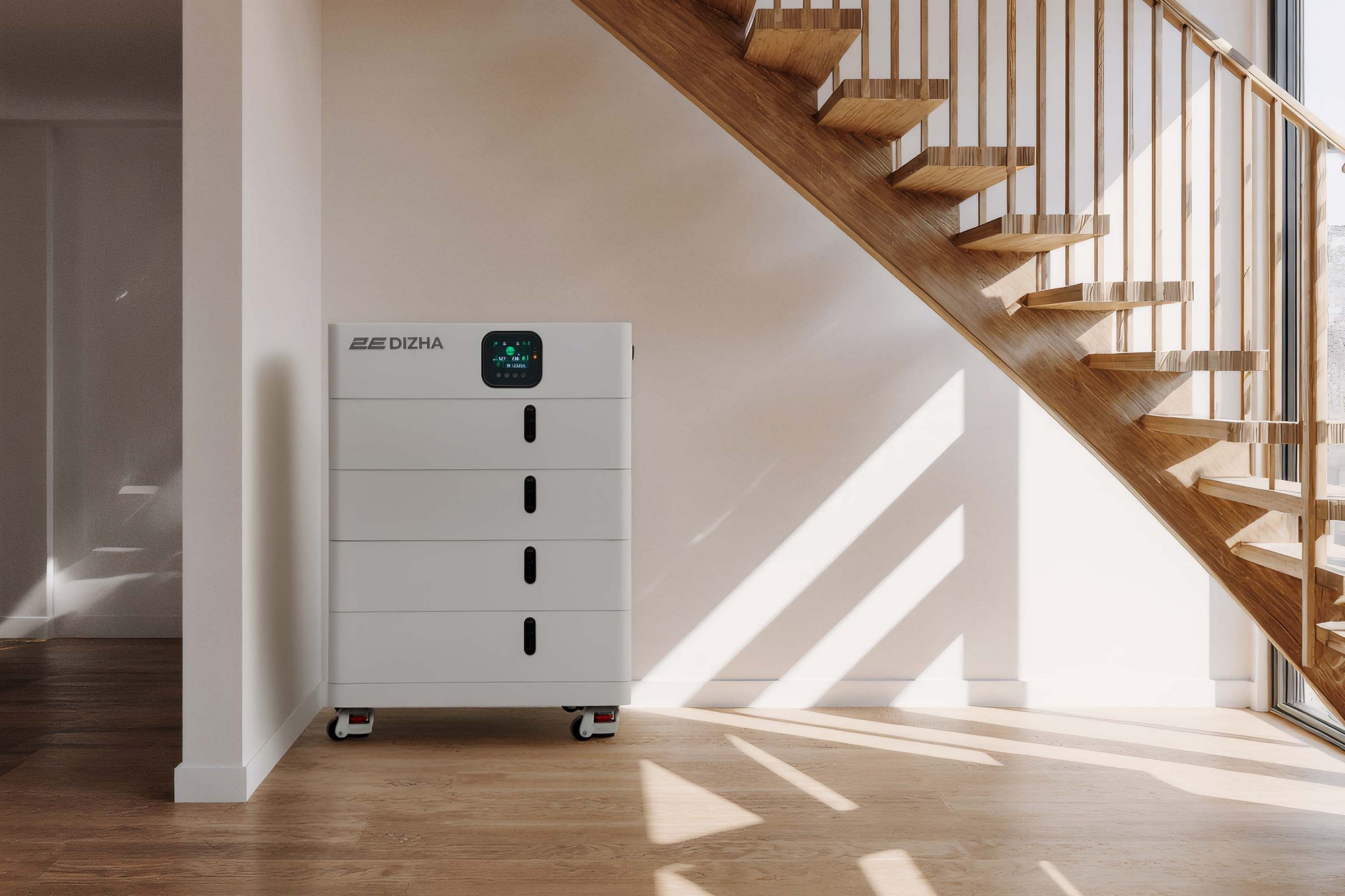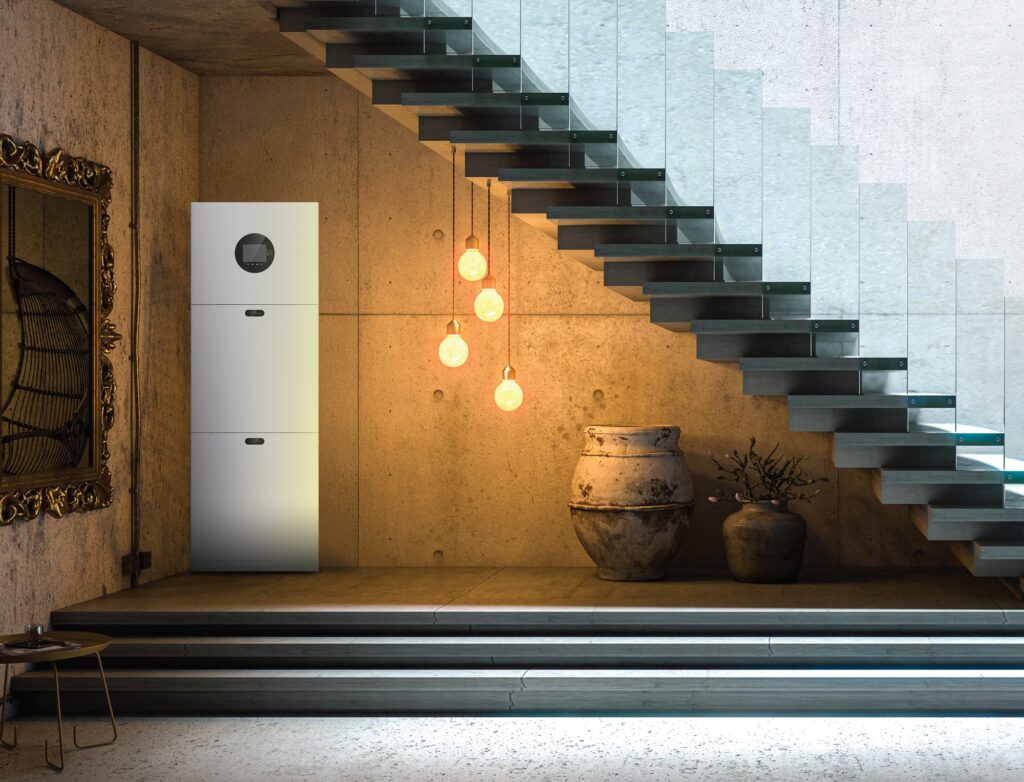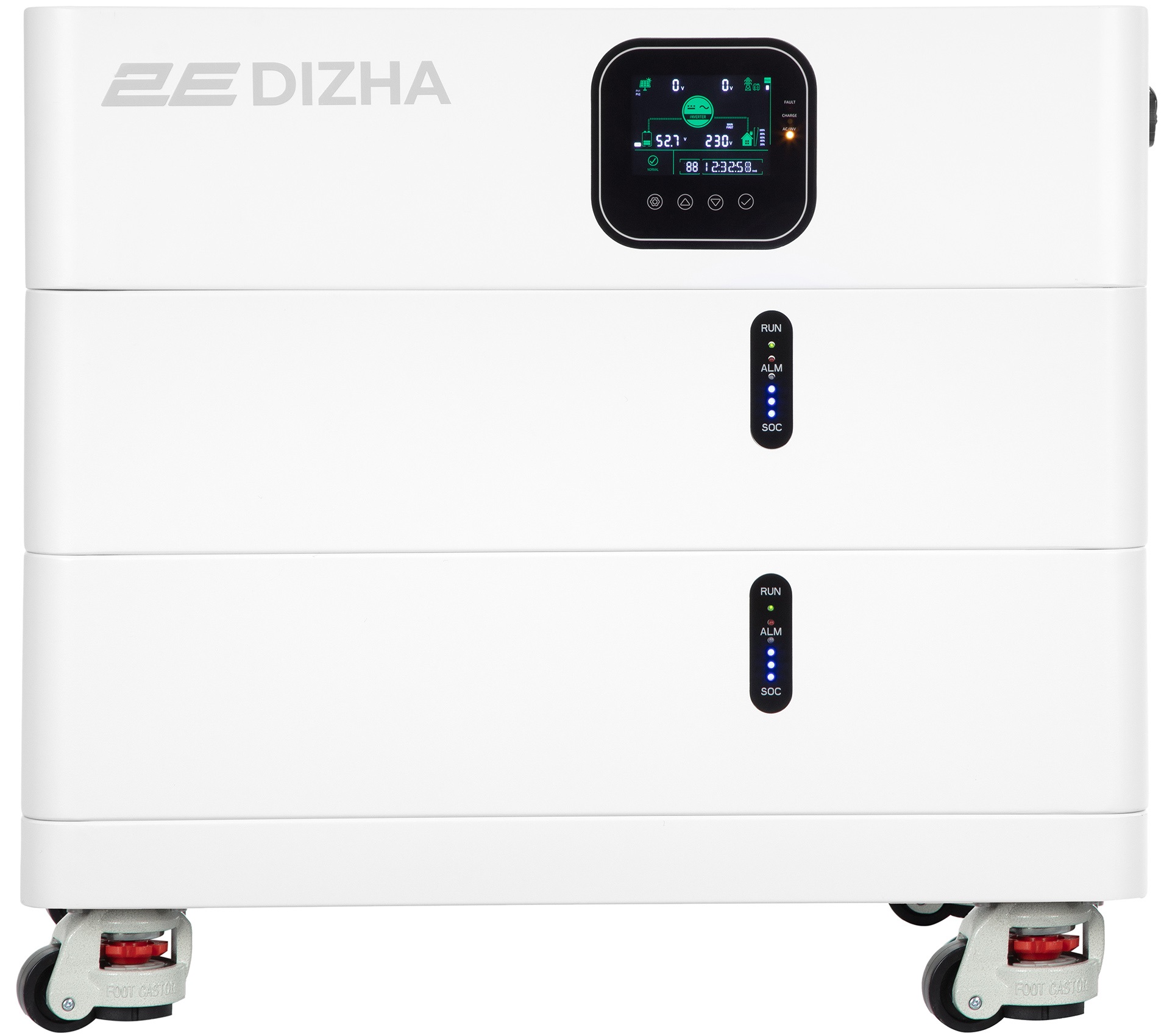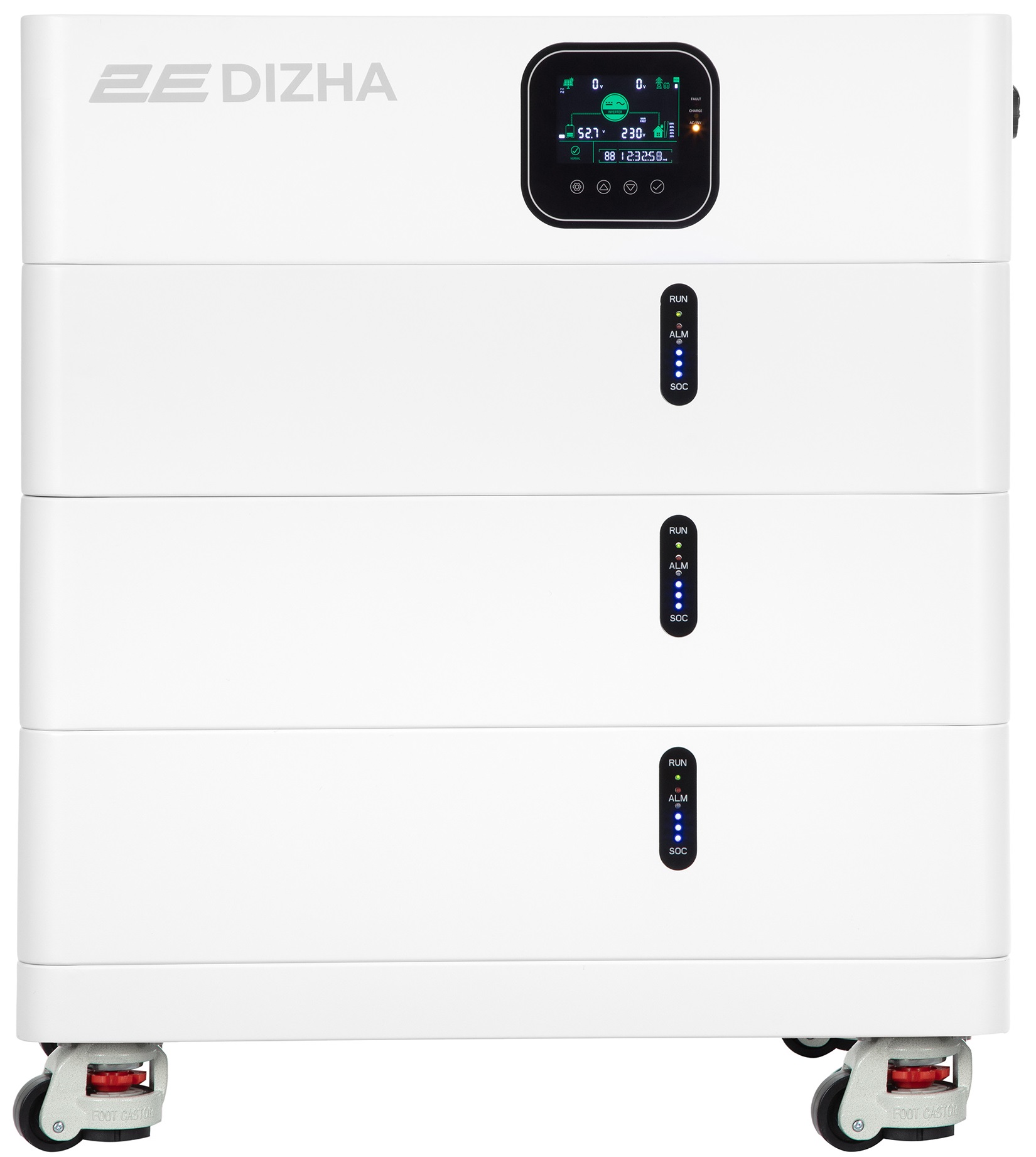PowerWall DIZHA is a unified solution designed for use in apartments, houses, and offices. Its ultra-compact form factor allows you to save space while maintaining style and interior harmony. Thanks to built-in wheels, the device is easy to transport. PowerWall 2E DIZHA is the most powerful backup power system in the 2E lineup, featuring a modern 10,000 W hybrid inverter with grid-feed capability.
A New Standard in Energy Systems
PowerWall DIZHA implements a revolutionary technology of wireless connection between inverter and battery modules – no more bulky cables, as both energy and data transfer within the system are carried out through a unique power interface.
The energy storage module uses high-performance lithium iron phosphate (LiFePO₄) batteries with a long service life. Its modular design ensures convenient scalability and maintenance. Each energy storage module is equipped with an intelligent BMS and can be combined into a battery pack with a total capacity of up to 25 kWh (5 storage modules). The energy capacity of each module is 5 kWh.
Possible Configurations of the PowerStation 2E DIZHA Backup Power System
| Model | Battery capacity | Rated output power | Rated output voltage (AC) | Frequency | Charging current | Max. photovoltaic power |
| 2E-ESS-PSD10-10 | 10,24 kWh | 10 000 W | 230 V | 50 Hz | 0~100 A | 11 000 W |
| 2E-ESS-PSD10-15 | 15,36 kWh | 10 000 W | 230 V | 50 Hz | 0~100 A | 11 000 W |
| 2E-ESS-PSD10-20 | 20,48 kWh | 10 000 W | 230 V | 50 Hz | 0~100 A | 11 000 W |
Note: Using five energy storage modules requires removing the wheels. The power module features an entirely new topological design that enables energy exchange between photovoltaic, grid, battery, and load systems, as well as supports both photovoltaic and grid charging functions.
The two photovoltaic charging modules employ the latest optimized MPPT monitoring technology, which allows rapid identification of the maximum power point of the photovoltaic array under any conditions, ensuring real-time extraction of maximum energy from the solar panels. Additionally, the MPPT system has a wide voltage range and supports a maximum photovoltaic array output of 11,000 W (2 × 5,500 W).
An advanced control algorithm is implemented in the grid charging module to enable fully digital dual closed-loop control of voltage and current. Its wide AC input voltage range and comprehensive input/output protection functions ensure stable and reliable battery charging and protection. The inverter module features a fully digital intelligent design that uses advanced PWM technology to generate a pure sine wave, converting DC to AC power. It can be used to power household appliances, electric tools, and other AC loads.
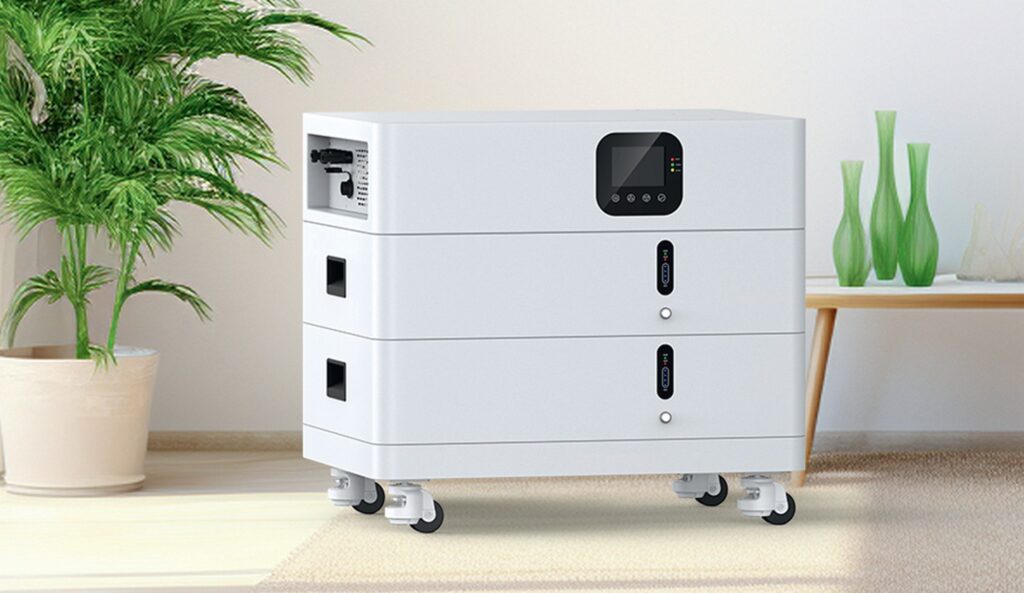
Four Main Inverter Modes of the DIZHA System:
- SNU* – Hybrid charging from photovoltaic systems and the power grid gives priority to photovoltaic systems, using the grid only when solar energy is insufficient. When solar power is adequate, grid charging stops automatically.
- CUB – Grid power is used by default, and photovoltaic charging is activated only when grid power is unavailable.
- CSO – Priority is given to photovoltaic charging; grid charging is activated only when the photovoltaic system completely stops supplying energy.
- OSO – Only photovoltaic charging is active; grid charging is disabled.
* Simultaneous charging from photovoltaic modules and the power grid is possible only when the bypass output is loaded; photovoltaic charging can be activated only while the inverter is running.
Technical Specifications of the DIZHA Inverter Module
| Inverter | Rated output power | 10 000 W |
| Maximum peak power | 15 000 W | |
| Power factor | 1 | |
| Rated output voltage | 230 AC V | |
| Frequency | 50 Hz | |
| Auto switching period | <10 ms | |
| THD | <3 % | |
| AC Input | Rated input voltage | 220/230 AC V |
| Input voltage range | 90–280 AC V | |
| Rated output power | 10 000 W | |
| Frequency | 50 Hz | |
| Overload current | 63 A | |
| Photoelectric Input | Solar charging type | MPPT |
| Maximum output power | 5 500 + 5 500 W | |
| PV input current | 22 + 22 A | |
| Operating voltage range | PV 120–500 V | |
| MPPT Voltage Range | 125–425 V | |
| Physical Characteristics | Operating Temperature Range | -10–55 °C |
| Storage Temperature Range | -25–60 °C | |
| Humidity Range | 5–95 % | |
| Usage Altitude | <2 000 m | |
| Cooling Mode | Forced air cooling | |
| Noise Level | 60 dB (А) | |
| Protection Class | IP20 | |
| Weight | 29 kg | |
| Size (L x W x H) | 650 × 460 × 160 mm |

Battery module
| Battery Type | LiFePO4 |
| Battery Energy | 5,12 kV·h |
| Battery Capacity | 100 A·h |
| Battery Nominal Voltage | 51,2 V |
| Battery Operating Voltage Range | 44,8–57,6 V |
| Standard Charging Current | 50 А |
| Standard Discharge Current | 50 А |
| Maximum Charging Current | 100 A |
| Maximum Discharge Current | 100 A |
| DOD | 80 % |
| Maximum number of parallel connections | 4 (with wheels), 5 (without wheels) |
| Estimated battery life | 6 000 cycles (80 % DOD, 0,5 °C, 25 °C) |
| Operating temperature | Charging 0–45 °C |
| Discharging -10–45 °C | |
| Operating temperature | 5–85 % |
| Usage altitude | <3 000 m |
| Protection class | IP20 |
| Recommended operating environment | Indoor |
| Weight | 48, kg |
| Size (l × d × h) | 650 × 460 × 150 mm |
Support for Multi-Zone Tariff Plans
VEZHA is equipped with a time-based charging and discharging function that allows users to set different charging and discharging periods according to local electricity tariffs. This enables efficient use of both grid electricity and solar energy, significantly improving the system’s economic efficiency and expanding opportunities for optimizing electricity costs.
Typical Topological Scheme of the DIZHA Backup Power System
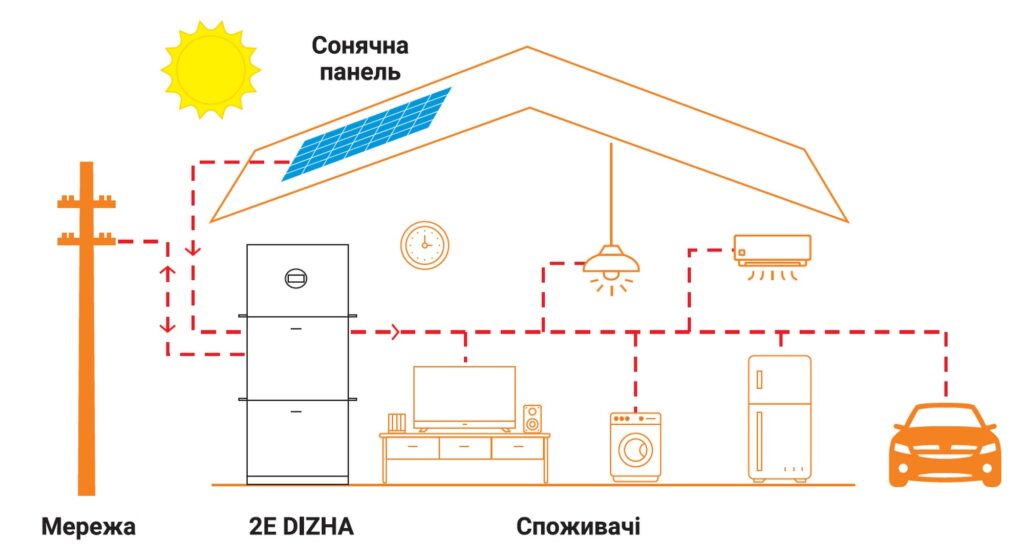
Even More Possibilities with PowerWall DIZHA:
- Support for parallel connection on a single phase to increase the total system power. By connecting up to six units in parallel, users can achieve up to 60 kW of nominal power and 150 kWh of total system capacity.
- Support for three-phase configuration: three DIZHA systems can be combined into a single three-phase 380 V setup. In this case, the line voltage between L1 (phase 1) and L2 (phase 2) equals 230 × 1.732 = 398 V AC; similarly, the line voltages between L1-L3 and L2-L3 are also 398 V AC. The voltage between L1-N, L2-N, and L3-N is 230 V AC. This configuration provides up to 60 kW of three-phase power and 150 kWh of total system capacity.
- Proprietary 2E Smart Energy remote monitoring system. This convenient application, compatible with iOS and Android devices (available in app stores), allows real-time monitoring of the 2E backup system’s status: current consumption, energy generation level, and many other parameters are not only displayed but also stored for future analysis.
